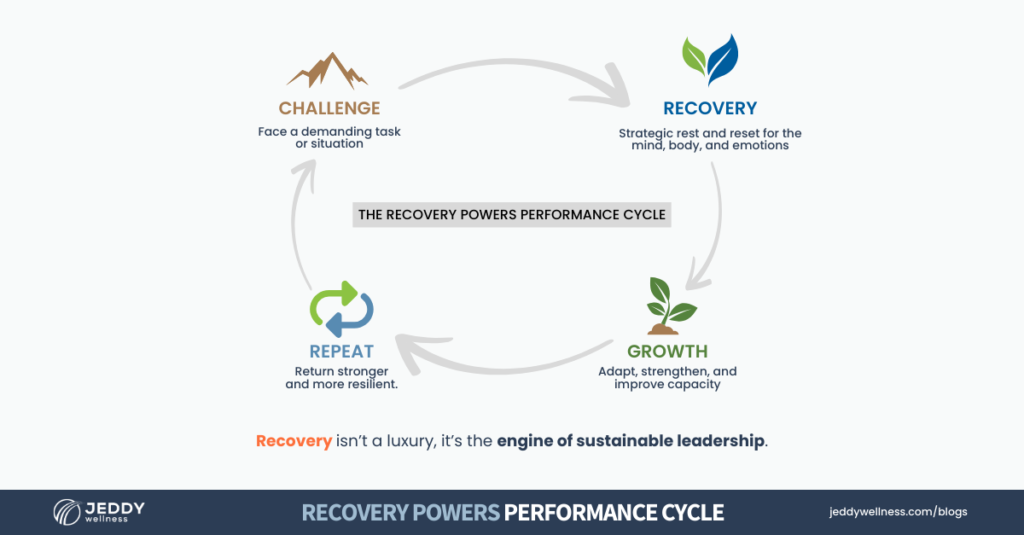“Resilience isn’t the absence of struggle, it’s mastery of recovery.”
For years, we’ve misunderstood what it means to be tough.
We thought it meant grinding harder. Showing no weakness. Pushing through, no matter the cost.
I saw it firsthand in my family’s business, where breaks were rare, burnout was normal, and your value was tied to how much you could endure.
That mindset still shows up in boardrooms and locker rooms everywhere.
But science and performance psychology tell a different story:
Recovery isn’t about pulling back completely. It’s about being intentional with what fills you back up. It’s not about doing nothing. It’s about doing the right things to replenish your energy, focus, and joy. And when leaders understand this shift, they unlock a new model for sustainable performance that reshapes how they work and how they lead.
The Myth of “Push Through” Culture
You’ve probably seen it:
A leader proudly skips lunch, powers through exhaustion, and replies to emails at 2 a.m.
At first, it looks like drive or tenacity.
But over time, morale dips, creativity vanishes, and teams disengage.
What begins as an effort to lead by example often leads to unspoken pressure:
“If I take a break, I’ll fall behind.”
“If I rest, I look weak.”
Burnout isn’t a badge. It’s a warning sign.
Sustainable leadership starts with self-awareness, not self-sacrifice (Self-Awareness: The Secret Skill That Sets Great Leaders Apart)
What you model, you multiply.
If you’re always on, your team assumes they should be too.
If you never log off, they won’t either.
But if you build recovery into your rhythm and speak openly about it you give your people permission to do the same.
Recovery isn’t just a personal habit, it’s a leadership responsibility.
The Foundation of Performance Is Wellness
You can’t lead well if you don’t feel well.
This goes far beyond physical health.
The missed sleep, skipped meals, and chronic stress all catches up to us and lowers your quality of life. When your quality of life suffers, so does your ability to show up fully, at work, at home, and for yourself.
It’s about emotional clarity, decision-making capacity, and showing up present for your team.
“The better you feel, the better you are at doing your job.” — Lewis Hamilton, 7x F1 World Champion
That insight doesn’t just apply to the racetrack, it applies to the workplace.
If you walk into meetings reactive, foggy, or disconnected, your team doesn’t just notice it, they absorb it.
Wellness is the first pillar of sustainable performance, and recovery is how you sustain it.
One of the most effective things a leader can do to improve team performance?
Model recovery. Not as a luxury but as a leadership standard.

The Science of Sustainable Leadership
Recovery isn’t soft. It’s strategic.
At the heart of sustainable leadership is adaptive capacity, your ability to take on challenges, recover, and grow.
Think of it like strength training:
You don’t grow during the rep. You grow between them.
Just like in training, recovery gives your mind and nervous system the reset it needs to perform consistently at a high level.
The Performance Cycle:
Challenge → Recovery → Growth → Repeat
Leaders who build in recovery rhythms, even the smallest ones, become better decision-makers, more emotionally available, and more creative under pressure.
That consistency also sends a message: recovery isn’t an indulgence. It’s how high performance is sustained.
Recovery Happens in Multiple Domains
The most effective leaders recover across three dimensions: cognitive, emotional, and social.
Here’s what that looks like in the workplace:
👉 Cognitive Recovery
- A marketing manager who builds in 10-minute breaks between strategy sessions restores clarity.
- Decision quality improves when leaders disconnect briefly even a walk around the office helps reset the mind.
👉 Emotional Recovery
- A team lead who journals after a tough feedback session processes more effectively than one who just powers through.
- Leaders who check in with themselves emotionally model emotional regulation for the team.
👉 Social Recovery
- A VP who schedules weekly coffee chats with peers creates support structures that make pressure feel manageable.
- Open communication fosters collective resilience, especially in fast-paced environments.
Key message: Recovery and wellness isn’t passive. It’s an intentional leadership discipline that supports sharper thinking, better decisions, and healthier teams.
Recovery Builds Culture
This isn’t just about mental health. It’s about performance culture.
Recovery creates psychological safety, the #1 factor in high-performing teams, according to Google’s Project Aristotle.
When recovery is respected, teams know they can pause, reset, and then re-engage—without guilt.
And it doesn’t take a policy overhaul to make it happen.
It starts with simple, visible behaviors from the top.
5 Ways to Recover Like a Leader
Start here:
- Block 5–10 minute buffers between meetings. We call this a “strategic pause”.
- Take one walking meeting per week
- Create a shutdown ritual even if it’s just closing your laptop and exhaling. Close your stress loops.
- Match tough work with your peak energy windows. This will conserve your resources and prevent resource loss spiral.
- Ask yourself: “What does recovery look like today for me and for my team?” The highly researched DRAMMA rest and recovery model teaches leaders how to integrate effective recovery practices.
Key message: These aren’t wellness trends. They’re leadership tools that reinforce the type of culture people want to be part of.
Final Thoughts
Recovery isn’t a break from leadership. It’s the foundation of sustainable performance.
The next time you feel the urge to power through, Pause. Reset. Then return stronger.
Written By: Jason Roeder and Sumana Jeddy
______________________________
Stay Connected with Jeddy Wellness
Discover evidence-based research and innovative strategies to build and activate healthier workplaces.
💬 Want to Build a Recovery-Driven Culture?
👉 Book a Recovery Strategy Session with Jeddy Wellness.
Learn how to lead with more clarity, energy, and consistency without burning out your people or yourself.

Before You Add More: Subtract What Drains You
It’s 11:15 PM. Your laptop is still open. You’ve put in 10+ hours every day this week. Your brain feels foggy, your eyes are sore,


